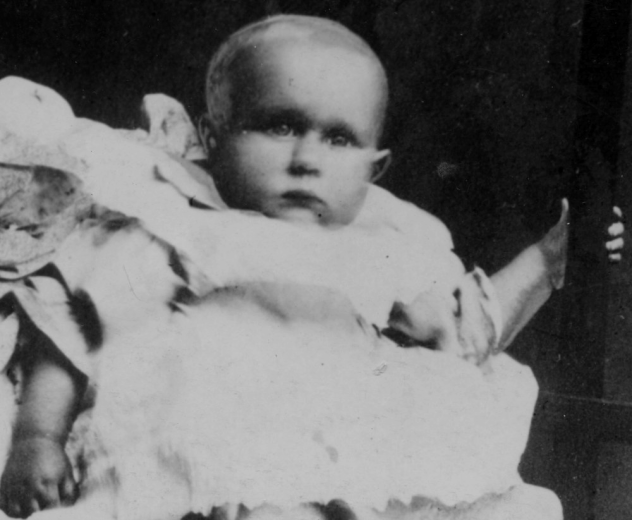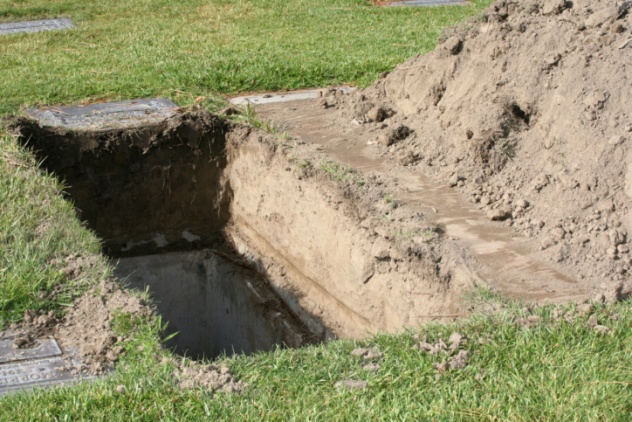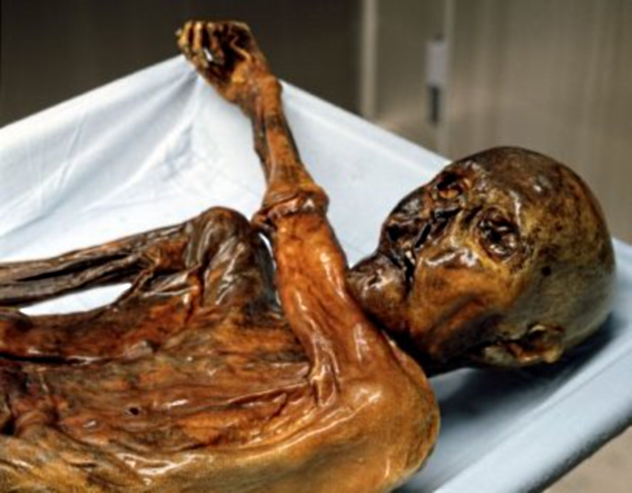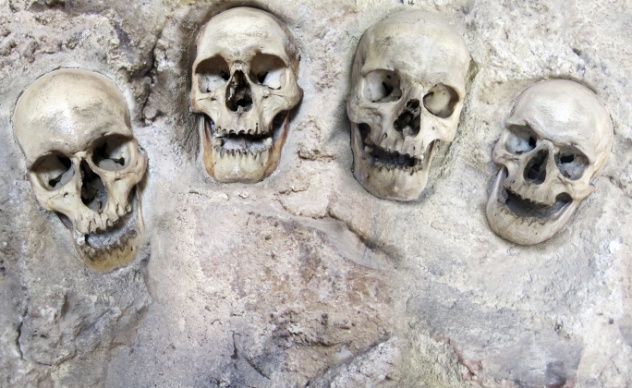 Weird Stuff
Weird Stuff  Weird Stuff
Weird Stuff  Mysteries
Mysteries 10 Tragic Disappearances and Deaths in Joshua Tree National Park
 History
History 10 Ways Childhood Really Sucked in the Old West
 Music
Music 10 Name Origins of Famous Bands from the 1990s
 Religion
Religion 10 Biggest Turnarounds by the Catholic Church
 Weird Stuff
Weird Stuff 10 Unbelievable Times Laws Had Unintended Consequences
 Humans
Humans Ten Historic Women Who Deserve Way More Credit Than They Got
 Movies and TV
Movies and TV 10 Films That Spawned Major Lawsuits
 History
History Ten Times Towns Were Wiped Off the Face of the Earth
 Creepy
Creepy 10 of the Most Disturbingly Haunted Public Houses in the UK
 Weird Stuff
Weird Stuff 10 Niche Subcultures That Are More Popular Than You Might Think
 Mysteries
Mysteries 10 Tragic Disappearances and Deaths in Joshua Tree National Park
 History
History 10 Ways Childhood Really Sucked in the Old West
Who's Behind Listverse?

Jamie Frater
Head Editor
Jamie founded Listverse due to an insatiable desire to share fascinating, obscure, and bizarre facts. He has been a guest speaker on numerous national radio and television stations and is a five time published author.
More About Us Music
Music 10 Name Origins of Famous Bands from the 1990s
 Religion
Religion 10 Biggest Turnarounds by the Catholic Church
 Weird Stuff
Weird Stuff 10 Unbelievable Times Laws Had Unintended Consequences
 Humans
Humans Ten Historic Women Who Deserve Way More Credit Than They Got
 Movies and TV
Movies and TV 10 Films That Spawned Major Lawsuits
 History
History Ten Times Towns Were Wiped Off the Face of the Earth
 Creepy
Creepy 10 of the Most Disturbingly Haunted Public Houses in the UK
10 Intriguing Historical Graveyard Finds
Burial sites attract our most morbid curiosities, and the older they are, the more mysterious they seem. These tantalizing time capsules can directly reveal what superstitions our ancestors feared or how they killed their enemies. Nothing else gives us such a direct link to those who have lived before. Graves are not just for fans of the macabre; forensic experts climb into them to learn the truth about tragedies, and archaeologists uncover new puzzles, ensuring that our fascination with the long-dead remains very much alive.
10 Unknown Baby From The Titanic

When the infamous Titanic sank underneath the surface of the Atlantic in 1912, the youngest body pulled from the waves was that of a baby boy. When he went unclaimed, he was buried in a graveyard in Nova Scotia, Canada, under a tombstone that simply identified him as the “Unknown Child.” Perhaps because he was blond and in the right age group, he was first thought to be a two-year-old Swedish baby called Gosta Leonard Palsson, whom witnesses had seen being washed overboard as the Titanic sank. In 2001, the Palsson family allowed the baby’s grave to be opened for DNA analysis. By then, only a piece of arm bone and a few teeth remained, but they were enough to prove that he wasn’t a Palsson. A second misidentification occurred in 2004 when the teeth were thought to be those of an infant from 9–15 months of age (the real boy was already 19 months old), and a one-year-old Finnish child, Eino Panula, was considered to be the Unknown Child.
It took seven more years before his shoes finally gave this nameless baby his real identity back. Having their doubts, researchers took another look at the leather booties kept at the Maritime Museum of the Atlantic and realized they were too big for a one-year-old child. The only remaining kid on the passenger list that fit was Sidney Leslie Goodwin from England. This time, the US Armed Forces DNA Identification Laboratory confirmed with certainty that the baby was indeed Goodwin. He had been traveling in third class with his family, all of whom perished at sea.
9 Hidden Cemetery

About 650 unidentified skeletons have been unearthed outside of Johannesburg, South Africa. A mine dump was being prepped for one last gold extraction in 2010, when security guards made the grisly discovery of human remains sticking through the soil. None of the corpses had been buried in coffins and no record exists of who they were individually, or even of the graveyard itself, despite the fact that it must’ve been one of the largest cemeteries in the area back in its day.
Dating back to the turn of the 20th century, the graveyard’s all-male population, aged 18–25 at the time of their deaths, was buried wrapped only in cowhide, blankets, or canvas. Somehow, the cemetery vanished from the records and inevitably disappeared from sight and memory when it became a mine dump. Since there are no tombstones either, archaeologists’ best hope is to restore the barest details to each body, like race and perhaps where they came from. They were most likely migrant miners; most were black and Chinese and very likely met their ends in that era’s mining industry, which was nothing better than a glorified death trap.
8 Rare Roman Gladiators

A puzzling grave site in York, England, where nearly 80 young men lie buried, is providing researchers with never-before-seen glimpses into what dangers Roman gladiators faced. The 1,800-year-old remains were originally theorized to be the victims of a military suppression campaign against rebels, until more discoveries proved that they were blood sport fighters.
Researchers determined that the muscles in the right arms of the men were much more powerful, something Roman writers had written about gladiators who trained from their teens onward, and they were also found decapitated. Removing the head from an opponent’s shoulders was a common end to a fight in the arena. Also, lion or tiger bites were found on the bones of many of the skeletons, the sort of standoff that could only have happened in the arena. It is the first time that Roman remains have been unearthed with such bite marks. Apart from being one of the best-preserved gladiator graveyards ever found, the discovery of so many violent injuries, some of which had healed and some not, makes it a significant find in understanding what gladiators went through on a daily basis.
7 The Missing Body

Thomas Curry’s short life was a tragic one. When he was about seven years old, his father, also called Thomas, shot himself and the boy’s mother. Then, in 1925, the teenaged Curry died under mysterious circumstances when he tried to run for his life from a notoriously cruel reform school. The coroner who did the autopsy listed a skull crushed by unknown means as the reason for death. The school, however, claimed that he had been hit by a train.
The Dozier School for Boys shut their doors in 2011 after hundreds of now-grown men who had attended the institution came forward with stories of torture, murder, and friends who had vanished. Curry had only been there for a month, but he became one of 96 students to die under the “care” of the School. In 2013, investigators found 55 children buried in a makeshift graveyard on the grounds. Since nine other runaways had all died, some from clear signs of violence such as gunshot wounds, hit-and-runs, or blunt force trauma, investigators wanted to determine if Curry had been murdered and decided to exhume his body. They arrived at his family plot in Philadelphia, where Curry had been buried without a tombstone on top of his great-grandparents. But when his coffin was cracked open, Thomas wasn’t there. The school had shipped a box full of wood to his family for burial. Curry’s body remains missing.
6 Giant Lemur Bones

Explorers have found a priceless collection of giant lemur skeletons and other extinct animals in a cave in Madagascar. While scientists are happy about the unprecedented chance to study the large lemurs, the mystery of how the graveyard came into existence is still not fully solved. The gorilla-sized lemurs got booted into extinction with the arrival of humans on the island between 2,000 and 500 years ago. While there’s almost no doubt that humans had a direct hand in their demise as a species, the specimens in the watery depths of Aven Cave in Tsimanampetsotse National Park showed no sign of being wounded by hunters or even of being eaten after death by scavengers. They were perfectly preserved and intertwined with the remains of other exotic extinct species such as the giant elephant bird. One possible theory is that the hundreds of bones, some of complete lemurs, washed into the cave over the course of centuries and settled down into the muddy bottom until they were rediscovered. Overall, however, the formation of the invaluable fossil spread remains a guessing game.
5 The Iceman’s Bloodline

Otzi the Iceman is a pretty famous mummy, known by scientists and the Internet community as that shriveled brown guy who was discovered in 1991 by hikers in the Otzal Mountains. The ancient murder victim, who died from an arrow wound and a crushed skull, left a lot behind for researchers to investigate, including tools, clues to what he ate, and how he was one of the earliest sufferers of Lyme disease now on record. Perhaps his most intriguing legacy is that his bloodline lives on. Because the 40-something was packed under snow after his death and then sealed off with strata of ice, his body was preserved enough to allow viable genetic testing. Scientists from Austria managed to isolate a rare genetic mutation in the 5,300–year-old corpse, one that only passes down the male line, and discovered that Otzi has at least 19 male descendants alive today. That number is likely to increase, since they are planning on testing more male Austrians in the future.
4 Impaled Skulls

In southeast Sweden, archaeologists found a rather unique cemetery. It consists of skulls impaled on sticks, and it’s at the bottom of a lake. The shallow lake has long since dried up, which made the discovery possible when excavations for a railway line started in the area. The 8,000-year-old site was used by a Stone-Age community to either bury their dead or ritually discard the heads of their enemies; researchers aren’t entirely certain. The 11 heads are adults of both genders and youngsters that range from children to babies. One woman’s skull had a temporal fragment from another female arranged inside of it. While heads on poles are historically nothing new, it would appear that this is the first and only example of this tradition from the Mesolithic Era. Since another find from that era supports the theory of ancient Swedes removing their dead from graves to give them a second, head-only burial, it is possible that the skulls were those of loved ones and not enemies.
3 Potted Pups

At Abydos, one of Egypt’s most ancient places, archaeologists made a very unusual discovery. They found five dogs preserved in pots, something never before seen, even in a country known for its obsessive animal burials. Two of the better-preserved 3,000-year-old dogs stumped the experts with the strangeness of their mummification. Due to the time and process of preparing a mummy, flexibility gets compromised to the point where a body would break if forced into a pot. Yet somehow, the large dogs were lowered into their containers without damage, and both were curled up in their jars as if they had been supple enough to be carefully arranged. No one knows how the Egyptians did it, but it’s possible that an unknown mummification technique was involved. Investigators are not even certain if the animals are really dogs, but it’s the closest species they agree on. Since they weren’t bandaged, another anomaly, the alleged dogs clearly show off their unusually long coats and strange, auburn coloring.
2 Vampire Cemeteries

Poland was a place that vampires avoided during medieval times; the folks there knew how to put down the undead. Those who didn’t escape the locals’ attention were found by construction workers building a road near the town of Gliwice. They made for a chilling grave site. Whoever had interred them in their final resting place had been desperate enough to make certain that they remained that way; the heads had been chopped off and placed on the lower part of their bodies.
In a graveyard in northwestern Poland, measures taken against a possible vampire uprising proved even more extreme. Six bodies were found with spikes forced down their throats, rocks shoved into their jaws, and scythes wedged across their necks, ready to decapitate them should they sit up to go and prey upon the living. The practice of removing somebody’s head was a normal Slavic procedure when diseases, such as cholera and TB, as well as decomposition, were still not fully understood and were blamed on the supernatural.
1 Miguel De Cervantes

Considered to be the world’s first best-selling author, Miguel de Cervantes passed away in 1616. He was a war veteran, poet, and creator of the unforgettable character Don Quixote. Despite the fact that Don Quixote was such a huge hit, author royalties didn’t exist back then, and Cervantes never grew wealthy. No tombstone marked his burial at the Convent of the Barefoot Trinitarians; by 60 years after his death, no one alive remembered where he was buried.
The location of his grave remained hidden for the next four centuries until 2014, when determined Spanish investigators descended on the convent with ground-penetrating radar and other high-tech equipment. Combing the site for months, they finally found a single crypt underneath the convent that contained the mixed remains of 16 skeletons. One of the most promising clues was a wooden box imprinted with the letters “M.C.” that held human bones. Researchers, drawing on historical references as well as their findings, now believe that they have solved the mystery of the missing author. Despite that, conclusive DNA confirmation will be made nearly impossible by the degraded condition of the bones and the fact that Cervantes has no descendants. It has since been announced that his body would be interred in a new grave at the same convent with full honors.








